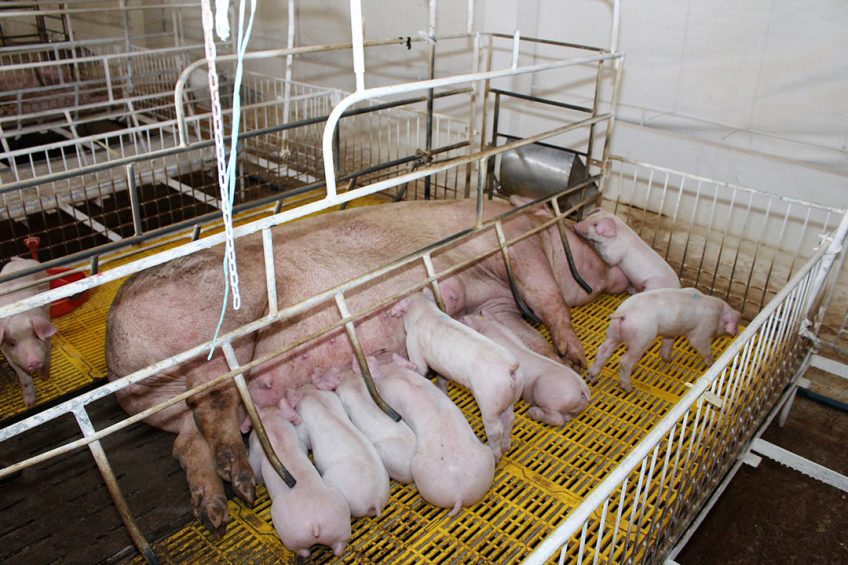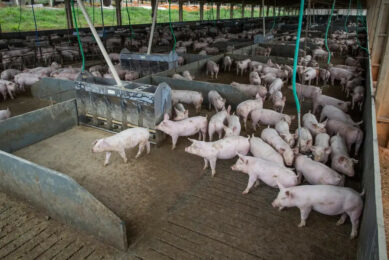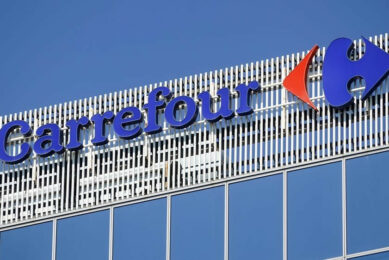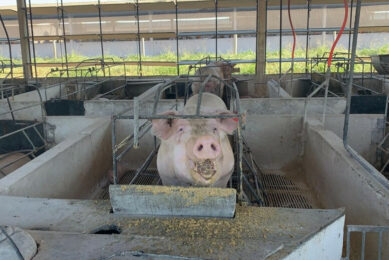Nutritional solutions for sows under heat stress

Increasingly, pig farms will have to cope with warmer temperatures. High temperatures can cause heat stress, with production disadvantages as a result. How does that work in practice and what can be done about it? Professor Bruno Silva explains.
For Professor Bruno Silva, the combination of ‘heat stress’ and ‘pig production’ does not hold many secrets. He is professor in swine nutrition and environmental adaptation at the Federal University of Minas Gerais (UFMG), in Montes Claros, Brazil. Minas Gerais is located north of Rio de Janeiro and São Paulo – entirely in a tropical zone. If any place is ideal for learning how to deal with hot temperatures and their effects on pig and sow performance, it is there.
Efficiency compromised
Recently, he featured in a webinar organised by Lallemand Animal Nutrition, titled ‘Nutritional solutions for lactating sows under heat stress’. Bottom line: efficiency is compromised every time environmental temperatures create a situation that is above or below particular threshold values. He said, “Nutrients have to be diverted to maintain the preservation of the animals’ natural or constant temperature.”
Inefficient thermoregulatory process
Pigs are highly susceptible to heat stress because they have a very inefficient thermoregulatory process, Prof Silva said. “They are very dependent on convective and conductive heat losses and on breath frequency, because they lack functional sweat glands.” Modern pigs, he added, have a high meat percentage, a high protein turnover; hence their metabolism produces more heat as well.
Several changes
Heat stress induces several changes, Prof Silva said. “Not only from a physiological or behavioural point of view, but also from a metabolic point of view. Because in the end, the animal has to survive; it has to adjust its metabolism to the new challenge.”
Rupture of the tight junctions
On a gut level, he said, the combination of all these heat stress factors can contribute to a rupture of the tight junctions, that is, a leaky gut. That will not only decrease the efficiency of digesting nutrients, but will also increase the susceptibility of the animal to immune challenges.
Reducing feed intake
One of the pig’s most effective measures to reduce heat production is to reduce feed intake, Prof Silva said. In order to understand that in more detail, he introduced the concept of “Thermal Effect of Feed” (TEF), that is, the contribution of feed to heat. The digestion of proteins, he said, generates more heat than does carbohydrates and fats, for instance. “The extent to which feed intake is reduced is directly related to metabolic rate and also to the productive stage.”
‘Adult sows suffer more’
Young sows, he said, eat at least 20% less than adult sows under heat stress conditions, because they have a lower intestinal tract capacity. “But when we look at the impact of reducing feed intake as a consequence of not having the possibility of thermoregulating – then you will see that the adult sows suffer more.”
What makes the difference after 7 days is that the piglets start demanding more nutrients from the sow
Prof Silva showed figures gathered by the university’s swine research facility (NEPSUI). On average, he said, sows during 24 days of lactation eat about 22% less in summer than in winter. He said, “Until the end of the first week, the feed intake is the same. What makes the difference after 7 days is that the piglets start demanding more nutrients from the sow. But due to the fact that the sows are under heat stress, they will not be able to increase milk production.”
Nocturnal eating pattern
Prof Silva also commented that sows have a nocturnal eating pattern. Irrespective of the season, sows tended to concentrate their feed intake between midnight and 10am in the morning. That happened to 75% of total feed intake in summer and 81% of total feed intake in winter.
Endocrine changes
How do sows adjust their metabolism under heat stress? That happens through changes in their hormonal profiles, Prof Silva explained. For instance, studies have shown an impact on thyroid hormones, a change in cortisol levels and in insulin levels.
Negative impact on milk production
This translates to a negative impact on milk production. He showed data from his own recent research on modern sow lines, showing a 19% reduction of milk yield when temperatures increased from 23˚C to 35˚C. That relates to the mammary gland having a relatively high temperature, that is, it contributes a larger part to heat production.
How can sows be helped?
Prof Silva discussed three different strategies that can be used to help sows cope with heat stress challenges. Genetics are possible, he said. Producers can choose animals for more robustness or can use thermo-tolerant genetics. Changing the environment is by far the most efficient, he says, but this often comes at a high cost.
Nutritional strategies
Nutritional strategies are a third option, with Prof Silva discerning between the options “dietary density” and “feed additives” – in short, a choice between trying to stimulate feed intake or trying to improve digestibility. Before delving deeper into this subject, he touched on water intake. In summer, he said, the sows drink 57% more than in winter. And water can also play a role in hydrating piglets. Normally they will ask for milk from the sow about 25 times per day. Under heat stress conditions, Prof Silva said, that doubles as the sow reduces her milk production, leading to irritated piglets, aggressive sows and a risk of crushing.
Changing dietary density
To change dietary density, the first step is to reduce crude protein levels in sow diets, Prof Silva said. Two studies, one of them by Prof Silva himself, showed that reducing crude protein levels increased feed intake 12–15%, as less crude protein lowers the TEF. Increasing dietary energy levels during lactation, however, did not make a difference. It makes sense, Prof Silva said; after all, under heat stress conditions the animals have fewer nutritional requirements.
Feed additives
He then moved on to discuss health and digestibility through feed additives. Betaine has the capacity to protect sows against osmotic and high temperature stresses. In studies by the UFMG, there were positive results for both the average individual and total litter weight of piglets at weaning. Similarly, both protected and unprotected butyrate showed positive results in terms of piglet performance, Prof Silva said. He went on to discuss the effect of antioxidant minerals and vitamins. If you throw heat stress on top of a systemic stress, it worsens the situation, he said. In addition, trace minerals like zinc could help to close gut leakage. Lastly, he looked into the use of live yeast (Saccharomyces cerevisiae var. boulardii), which can improve fermentation in the hindgut, reducing constipation levels. Adding the yeast to sow diets in late gestation helps to increase the number of piglets born alive, Prof Silva said. It also stimulated sow feed intake in lactation and changed the profile of the milk, having an indirect effect on piglet performance. He closed off his analysis with some comments on flavour and how that can influence sow feed intake – up to 23% higher.
Prof Silva therefore concluded: “By playing around with the feed composition and feed additives, we could enhance feed intake.”
This article is an approved summary of a webinar organised by Lallemand Animal Nutrition in its ‘Meet the Expert’ series. It was broadcast on Tuesday 26 May 2020.











